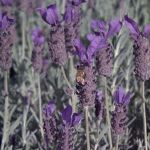
|
| Italian Lavenders |
A genus of about 25 aromatic, evergreen perennials and shrubs that are found throughout Mediterranean regions, the Middle East, nd India. Lavenders are among the most popular plants for herb gardens for their subtle coloring and delightful fragrance. The hardier lavenders make attractive hedges, while tender kinds may be grown under cover. Lavenders are rich in volatile oils, and the resulting essential oils vary greatly in aroma, constituents, and quality. Due to their popularity and long history of cultivation, garden lavenders are mostly hybrids and cultivars, and accurate identification is often extremely difficult. The two most important lavenders with medicinal uses are Lavandula angustifolia and L. latifolia. The former grows at higher elevations (600-1200m/2000-4000ft) in S. Europe and therefore thrives and yields well in cooler areas. Both are rich in essential oils but differ in constituents; L. angustifolia yields an exquisitely scented oil, known in France as fine, which is used in aromatherapy and high quality perfumes; L. latifolia, a lowland species, yields much larger quantities of a rather harsh camphoraceous oil, which is used mainly in cleaning products, and as an insect repellent. Lavandula latifolia is rarely seen as a garden plant but is grown in Spain for its oil. The hybrid lavender or lavandin, L. x intermedia (a cross between L. angustifolia and L.latifolia that appeared c. 1900), is often preferred by the perfume industry, but it is not recommended for medicinal use. It is grown on a large scale for its oil, and for its flowers, which are used in sachets, potpourri, and craft work. Lavandin combines the best properties of its parents, having a more pleasant perfume then L. latifolia, and yielding over four times as much oil as L. angustifolia. For many years lavender production centered on Provence in S France, but other countries, such as Japan, Australia, and New Zealand, increased production during the late 20th century. Lavandula stoechas was widely used as an antiseptic and toiletry herb in ancient times by the Greeks, Romans, and Arabs, but is little used today. It has a pungently scented volatile oil, containing 24-72 percent camphor.
Bushy shrub with linear to oblong-lanceolate, downy leaves, to 4cm (1½in) long, and flowering stems 3-4cm (1¼-1½in) long, bearing dark purple flowers in dense, short spikes, 2-3cm (¾-1¼in) long, tooped by purple bracts. Often on acid soil.
Magical Aromatherapy by Scott Cunningham Copyright © 1989 Llewellyn Publications Inc. pp. 101-103 Wicca, Guide to the Solitary Practioner by Scott Cunningham Copyright © 1988 Llewellyn Publications, Inc. pp. 159-168 The Encyclopedia of Herbs by Deni Bown Copyright © 1995, 2001 Dorling Kindersley Limited pp.252-257 | ||||||||||||||||||||||||||||||||||||||||||||||